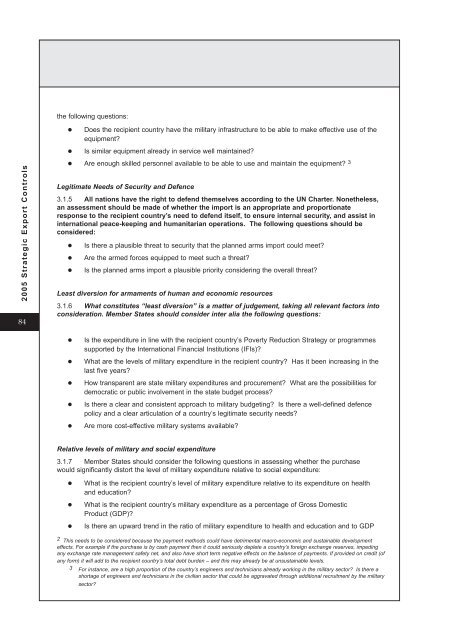Annex A - Official Documents
Annex A - Official Documents
Annex A - Official Documents
Create successful ePaper yourself
Turn your PDF publications into a flip-book with our unique Google optimized e-Paper software.
2005 Strategic Export Controls<br />
84<br />
the following questions:<br />
� Does the recipient country have the military infrastructure to be able to make effective use of the<br />
equipment?<br />
� Is similar equipment already in service well maintained?<br />
� Are enough skilled personnel available to be able to use and maintain the equipment? 3<br />
Legitimate Needs of Security and Defence<br />
3.1.5 All nations have the right to defend themselves according to the UN Charter. Nonetheless,<br />
an assessment should be made of whether the import is an appropriate and proportionate<br />
response to the recipient country’s need to defend itself, to ensure internal security, and assist in<br />
international peace-keeping and humanitarian operations. The following questions should be<br />
considered:<br />
� Is there a plausible threat to security that the planned arms import could meet?<br />
� Are the armed forces equipped to meet such a threat?<br />
� Is the planned arms import a plausible priority considering the overall threat?<br />
Least diversion for armaments of human and economic resources<br />
3.1.6 What constitutes “least diversion” is a matter of judgement, taking all relevant factors into<br />
consideration. Member States should consider inter alia the following questions:<br />
� Is the expenditure in line with the recipient country’s Poverty Reduction Strategy or programmes<br />
supported by the International Financial Institutions (IFIs)?<br />
� What are the levels of military expenditure in the recipient country? Has it been increasing in the<br />
last five years?<br />
� How transparent are state military expenditures and procurement? What are the possibilities for<br />
democratic or public involvement in the state budget process?<br />
� Is there a clear and consistent approach to military budgeting? Is there a well-defined defence<br />
policy and a clear articulation of a country’s legitimate security needs?<br />
� Are more cost-effective military systems available?<br />
Relative levels of military and social expenditure<br />
3.1.7 Member States should consider the following questions in assessing whether the purchase<br />
would significantly distort the level of military expenditure relative to social expenditure:<br />
� What is the recipient country’s level of military expenditure relative to its expenditure on health<br />
and education?<br />
� What is the recipient country’s military expenditure as a percentage of Gross Domestic<br />
Product (GDP)?<br />
� Is there an upward trend in the ratio of military expenditure to health and education and to GDP<br />
2 This needs to be considered because the payment methods could have detrimental macro-economic and sustainable development<br />
effects. For example if the purchase is by cash payment then it could seriously deplete a country’s foreign exchange reserves, impeding<br />
any exchange rate management safety net, and also have short term negative effects on the balance of payments. If provided on credit (of<br />
any form) it will add to the recipient country’s total debt burden – and this may already be at unsustainable levels.<br />
3 For instance, are a high proportion of the country’s engineers and technicians already working in the military sector? Is there a<br />
shortage of engineers and technicians in the civilian sector that could be aggravated through additional recruitment by the military<br />
sector?

















